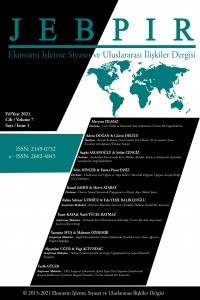Yarışılabilir Piyasalar Teorisi: Potansiyel Rekabetin Önemi
Yarışılabilir Piyasalar Teorisi, Tam Rekabet Piyasası, Potansiyel Rekabet, Havayolu Sektörü, Bankacılık Sektörü
___
- Asheim, G.B., (1992), “Contestability in a Resource Market with Non-Convex Costs”. The Scandinavian Journal of Economics, 94(4), s.609-618. [Erişim Tarihi: 19.06.2012, http://www.jstor.org].
- Bailey, E., (1981), “Contestability and the Design of Regulatory and Antitrust Policy”. The American Economic Review, 71(2), s.178-183. [Erişim Tarihi: 28.12.2011, http://www.jstor.org].
- Baily, E.E. ve Panzar, J.C., (1981), “The Contestability of Airline Markets During the Transition to Deregulation”. Law and Contemporary Problems”, 44(19), s.125-145. [Erişim Tarihi: 26.07.2017, http://www.jstor.org].
- Baumol, W.J., (1982), “Contestable Markets: An Uprising in the Theory of Industry Structure”. The American Economic Review, 72(1), s.1-15. [Erişim Tarihi: 10.11.2010, http://www.jstor.org].
- Baumol, W.J., Panzar, J.C., Willig, R.D., (1982), Contestable Markets and The Theory of Industry Structure. New York: Harcourt Brace Jovanovich, Inc.
- Brock, W. A., (1983), “Contestable Markets and the Theory of Industry Structure: A Review Article”. The Journal of Political Economy, 91(6), s.1055-1066. [Erişim Tarihi: 10.11.2010, http://www.jstor.org].
- Cairns, R.D. ve Mahabir, D., (1988), “Contestability: A Revisionist View”. Economica, New Series, 55(218), s.269-276. [Erişim Tarihi: 14.06.2012, http://www.jstor.org].
- Davut, L., (2002), Sanayi İktisadı Piyasa Yapısı Unsurları. Ankara: İmaj Yayıncılık.
- Günalp, B. ve Özel, H., (2005), “Rekabet Politikalarının Esasları”. Siyasa, 1(1), s.63-84. Erişim Tarihi: 26.07.2017. http://yunus.hacettepe.edu.tr/~ozel/YAYIN%20PDF/H%20Ozel%20 B%20Gunalp%20Siyasa.pdf.
- Goolsbee, A. ve Syverson, C., (2008), “How Do Incumbents Respond to the Threat of Entry? Evidence from the Major Airlines”. The Quarterly Journal of Economics, 123(4), s.1611-1633. [Erişim Tarihi: 26.07.2017, http://www.jstor.org].
- Maddala, G.S., Miller, E., (1989), Microeconomics: Theory and Applications. USA: McGraw-Hill, Inc.
- Mclntosh, J., (2002), “A Welfare Analysis of Canadian Chartered Bank Mergers”. The Canadian Journal of Economics, 35(3), s.457-475. [Erişim Tarihi: 19.06.2012, http://www.jstor.org].
- Mamatzakis, E., Staikouras, C., Koutsomanoli, N., (2005), “Competition and Concentration in The Banking Sector of Southeastern European Region”. Emerging Markets Review, (6), s.192-209. [Erişim Tarihi: 08.05.2013, http://www.sciencedirect.com].
- Martin, S., (2000), “The Theory of Contestable Markets”. Erişim Tarihi: 02.12.2010, http://www.krannert.purdue.edu/faculty/smartin/aie2/contestbk.pdf
- Molyneux, P., Thornton, J. ve Lloyd-Williams, D.M., (1996), “Competition and Market Contestability in Japanese Commercial Banking”. Journal of Economics and Business, (48), s.33-45. [Erişim Tarihi: 20.06.2013, http://www.sciencedirect.com].
- Morrison, S.A., ve Winston, C., (1987), “Empirical Implications and Tests of the Contestability Hypothesis”. The Journal of Law & Economics, 30(1), s.53-66. [Erişim Tarihi: 26.07.2017, http://www.jstor.org].
- Nathan, A. ve Neave, E.H., (1989), “Competition and Contestability in Canada's Financial System: Empirical Results”. The Canadian Journal of Economics, 22(3), s.576-594. [Erişim Tarihi: 26.06.2013, http://www.jstor.org].
- Neuberger, D., (1997), “Structure, Conduct and Performance in Banking Markets”, Erişim Tarihi: 26.06.2013, http://www.wiwi.uni-rostock.de/fileadmin/Institute/VWL/ VWL-Institut/RePEc/pdf/wp012thuenen.pdf.
- Northcott, C. A., (2004), Competition in Banking: A Review of the Literature.http://www.bankofcanada.ca/wp-content/uploads/2010/02/wp04-24.pdf.
- Perrakis, S., (1982), “Contestable Markets and the Theory of Industry Structure by William J. Baumol; John C.Panzar; Robert D. Willig”. The Canadian Journal of Economics, 15(4), s.774-780. [Erişim Tarihi: 14.06.2012, http://www.jstor.org].
- Shy, O., (1995), Industrial Organization: Theory and Applications. New York: Massachusetts Institute of Technology.
- Weitzman, M.L., (1983), “Contestable Markets: An Uprising in the Theory of Industry Structure: Comment”. The American Economic Review, 73(3), s.486-487. [Erişim Tarihi: 10.11.2010, http://www.jstor.org].
- Yano, M., (2006), “A Price Competition Game Under Free Entry”. Economic Theory, 29(2), s.395-414. [Erişim Tarihi: 19.06.2012, http://www.jstor.org].
- Yıldırım, K., Eşkinat, R., Kabasakal, A., Erdoğan, M. (2009), Endüstriyel Ekonomi. Bursa: Ekin Basın Yayın Dağıtım.
- ISSN: 2149-0732
- Yayın Aralığı: Yılda 2 Sayı
- Başlangıç: 2015
- Yayıncı: Kırıkkale Üniversitesi
Yarışılabilir Piyasalar Teorisi: Potansiyel Rekabetin Önemi
Finansal İstikrar ve Makro İhtiyati Politikalar Üzerine Bir Değerlendirme
Ankara’da AHP ve PROMETHEE Yaklaşımıyla Monoray Hat Tipinin Belirlenmesi
Merve Taş, Şeyma Nur Özlemiş, Mustafa Hamurcu, Tamer Eren
SMEs and Contract Management; an Empirical Study on Turkish Companies
Katılımcı Yönetimin İş Doyumu Üzerine Etkisi: Akademik Personel Üzerinde Bir Araştırma
